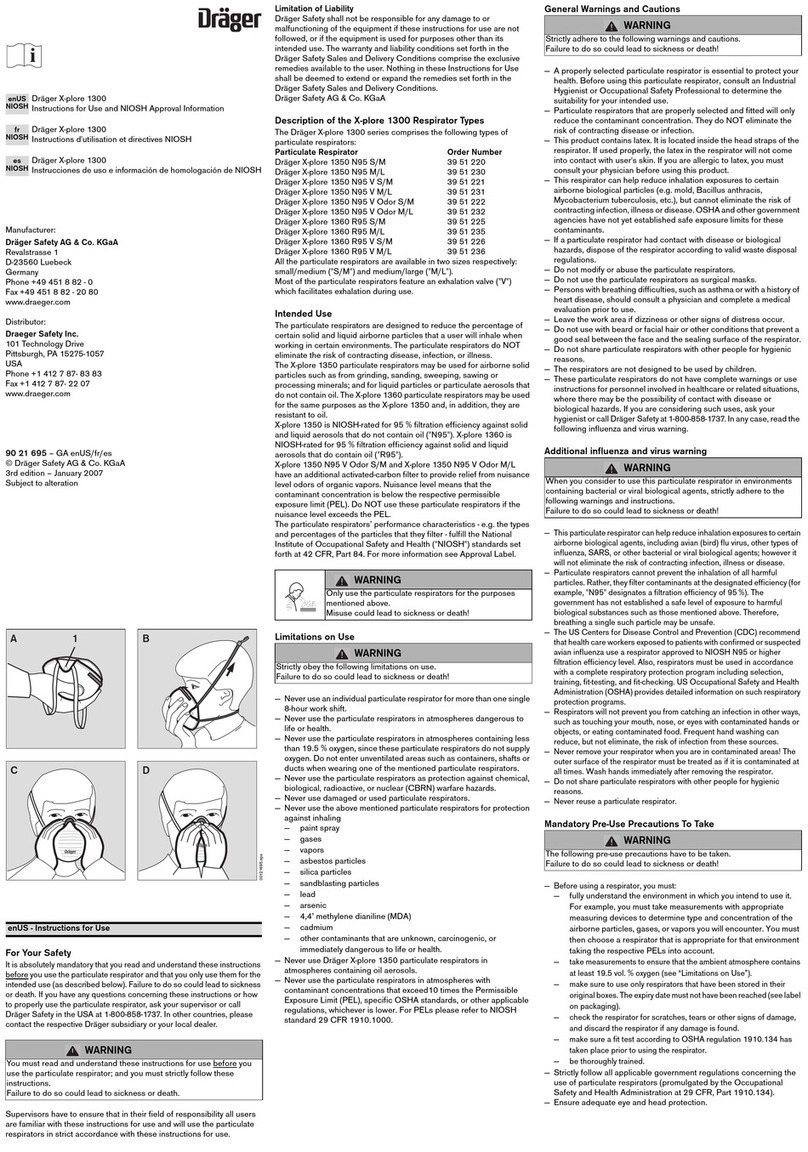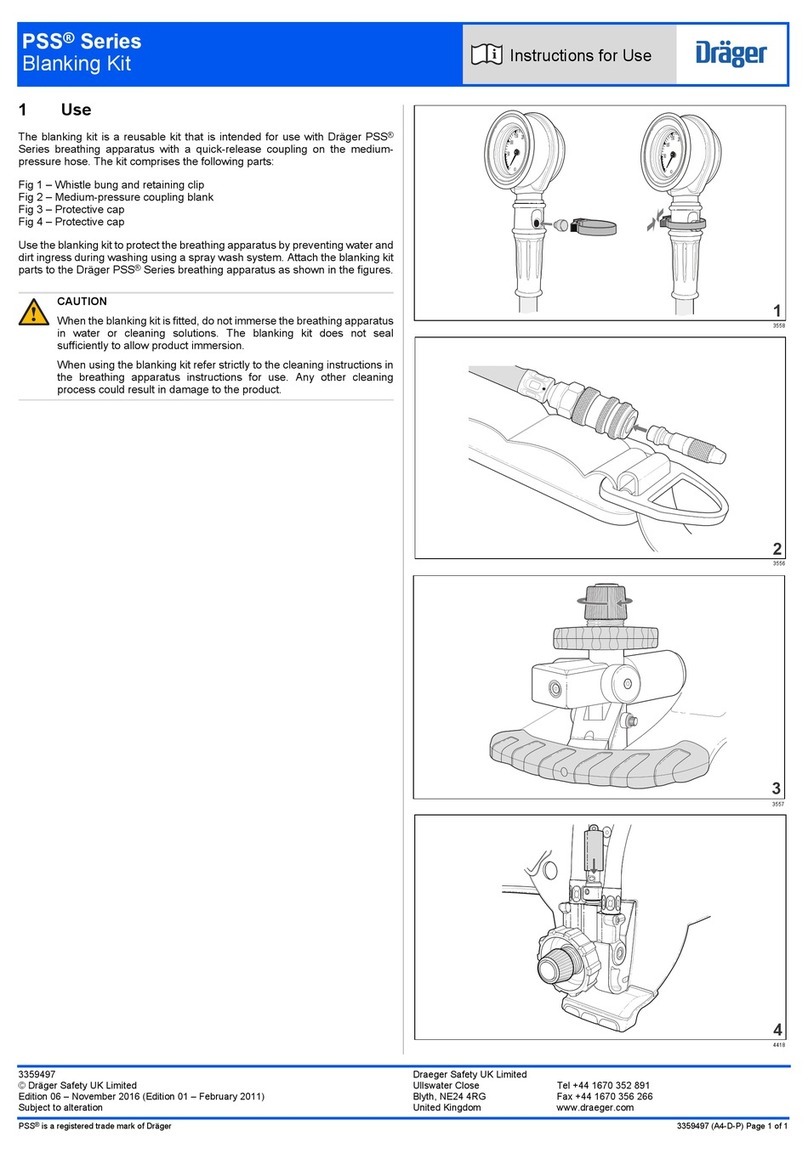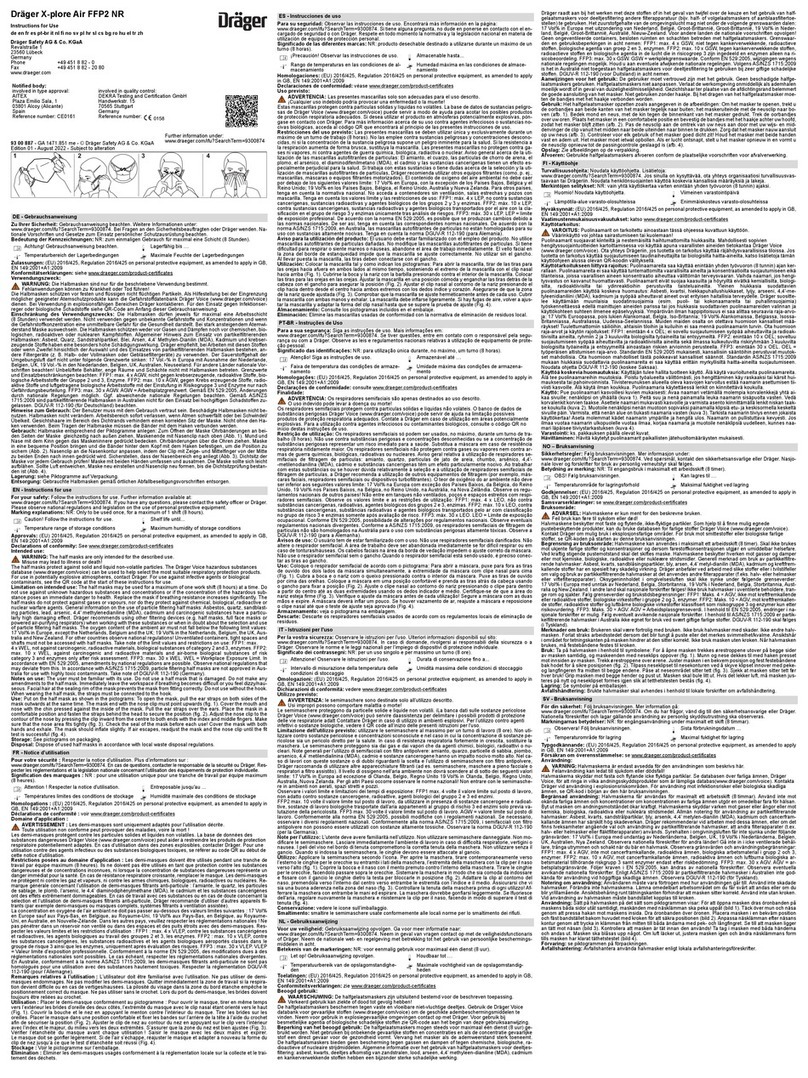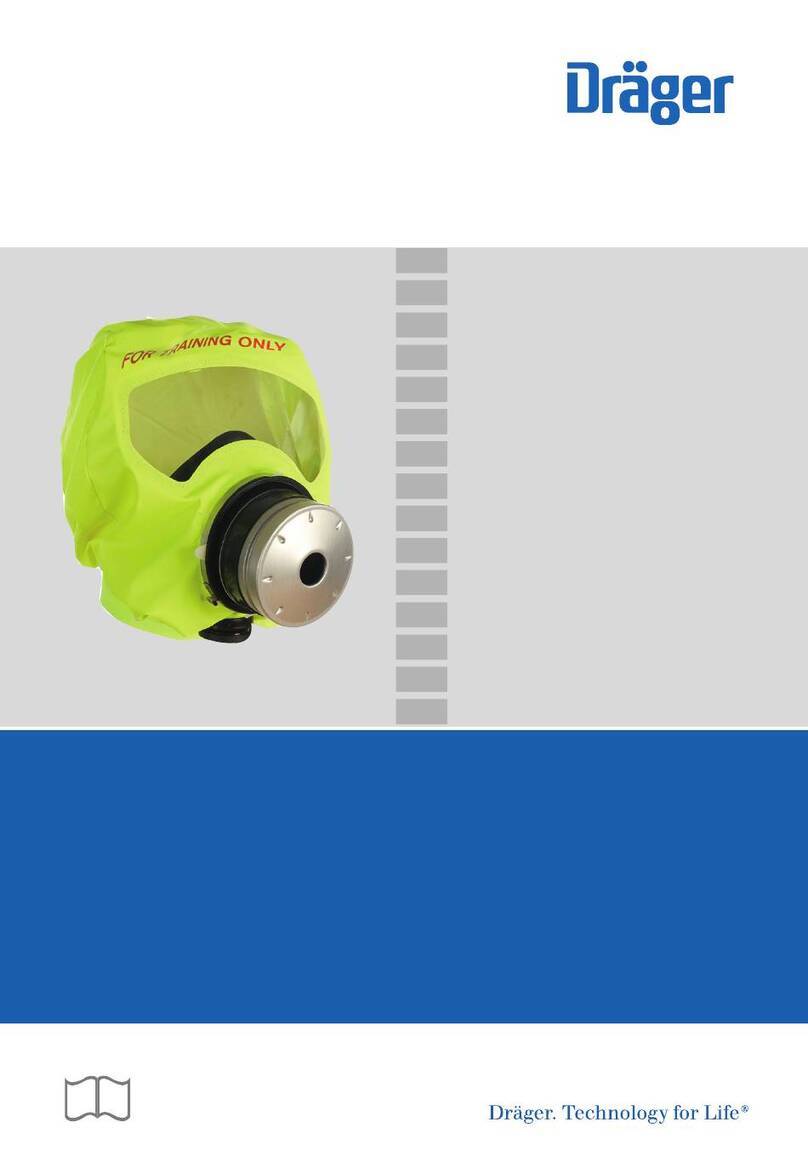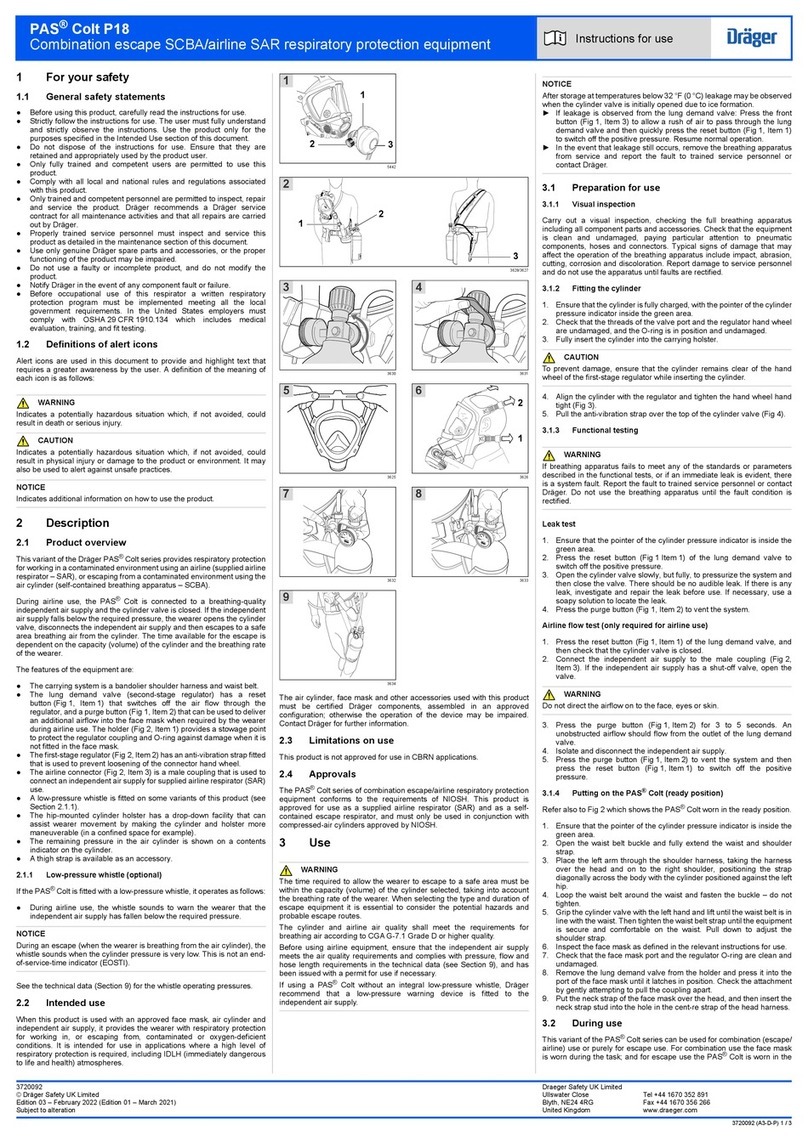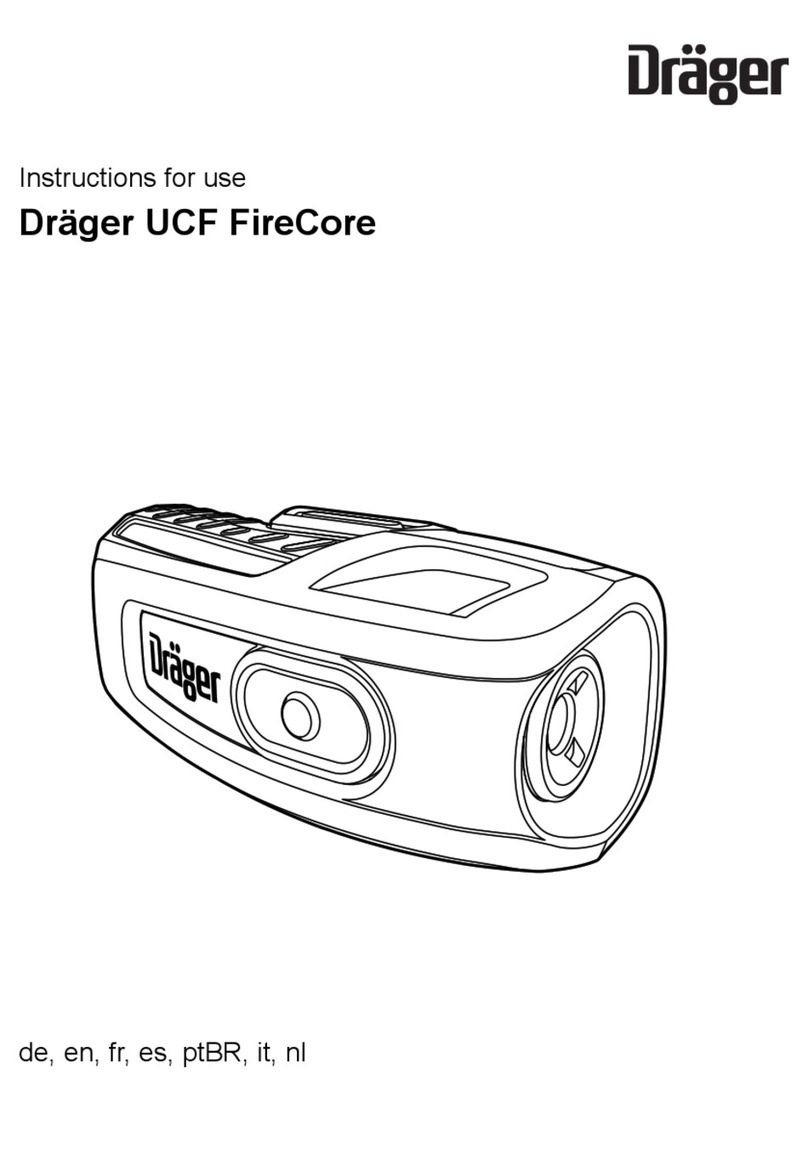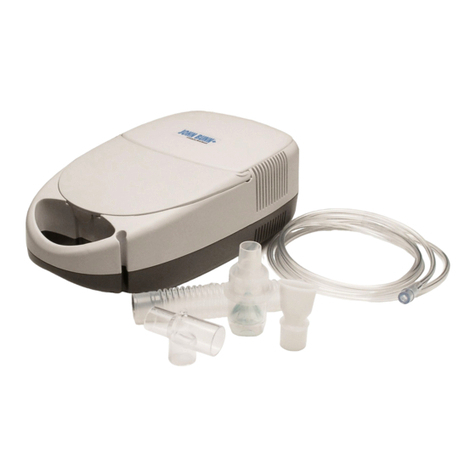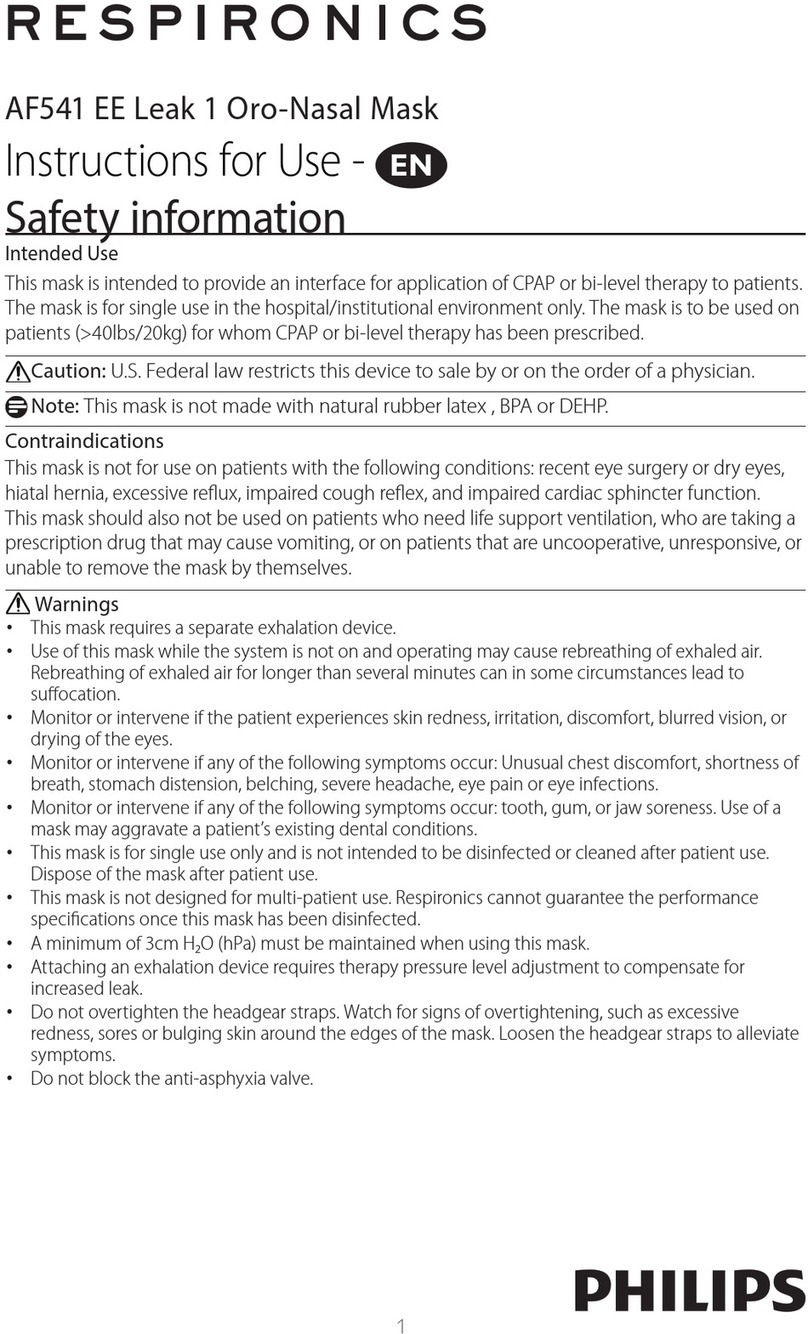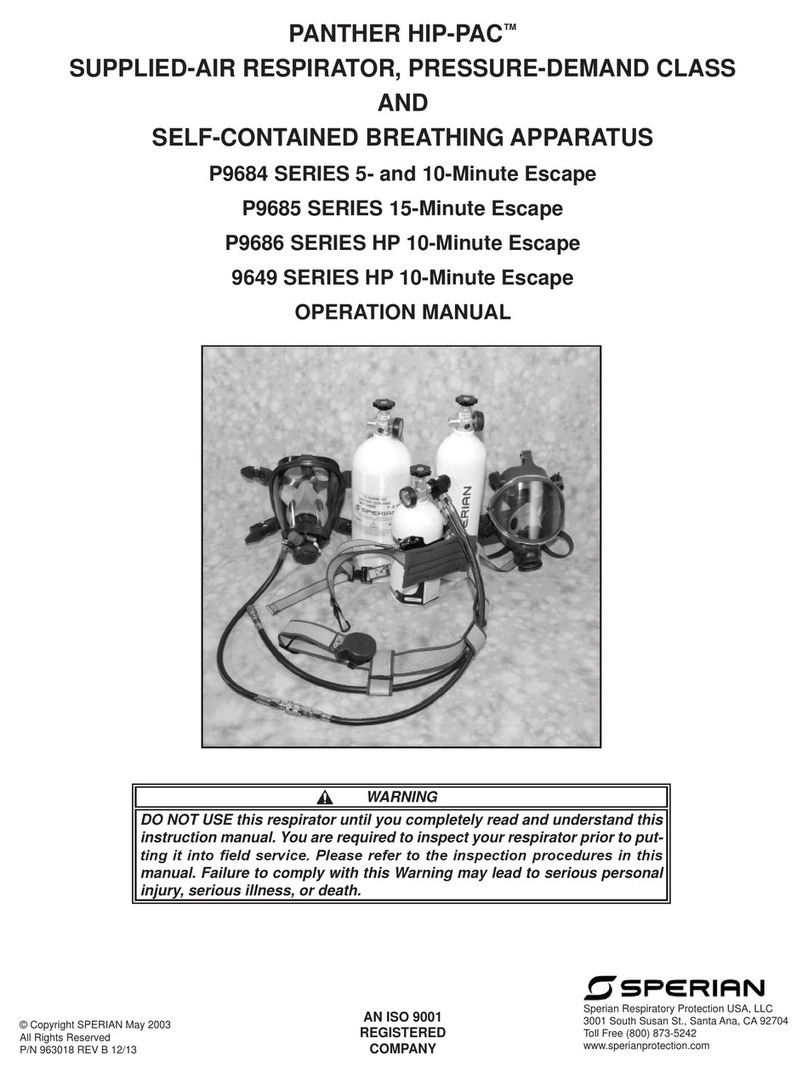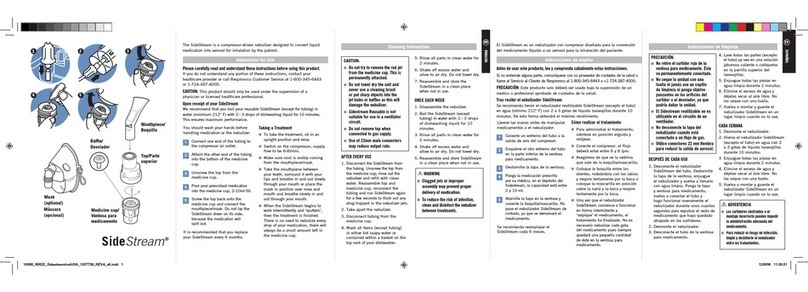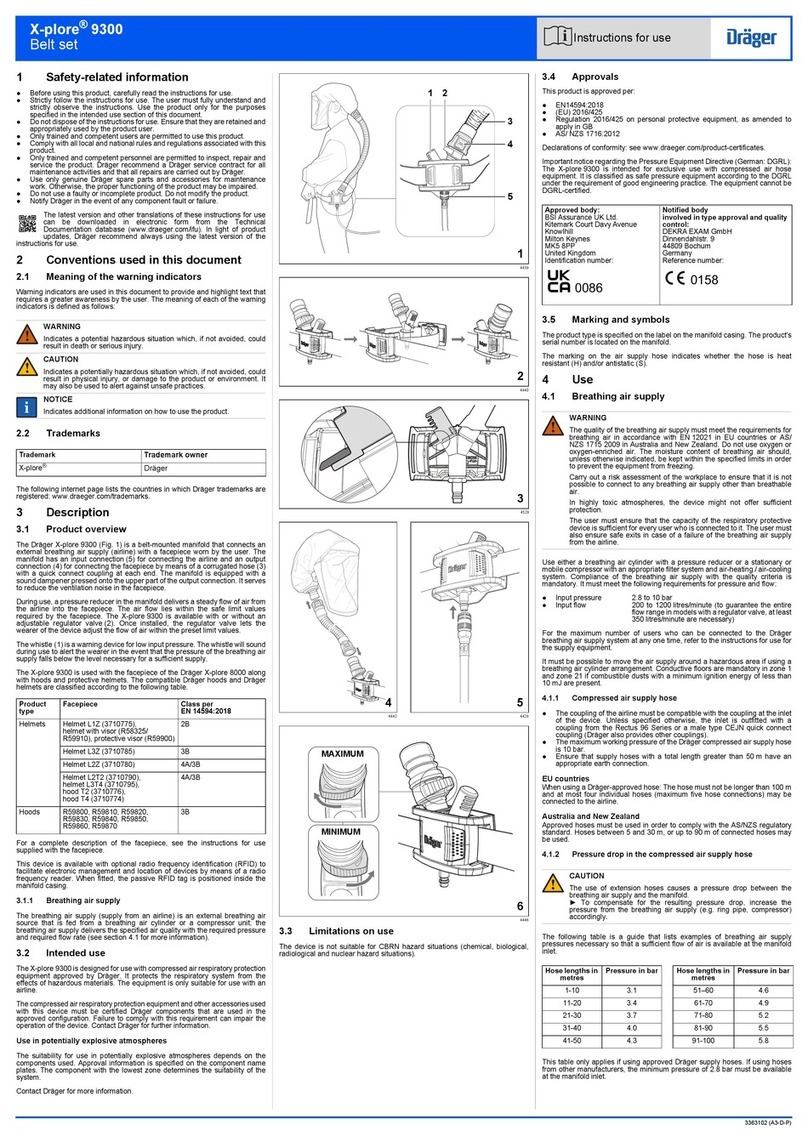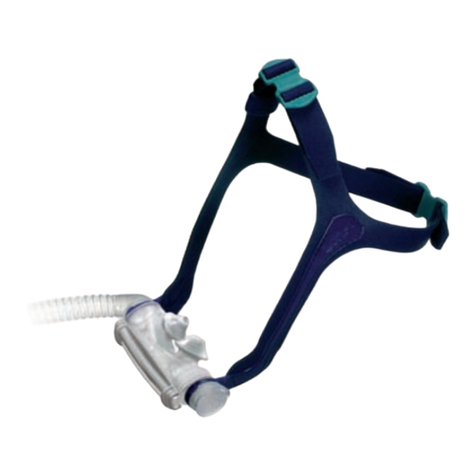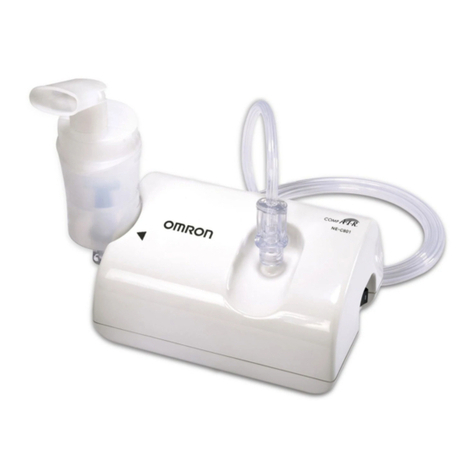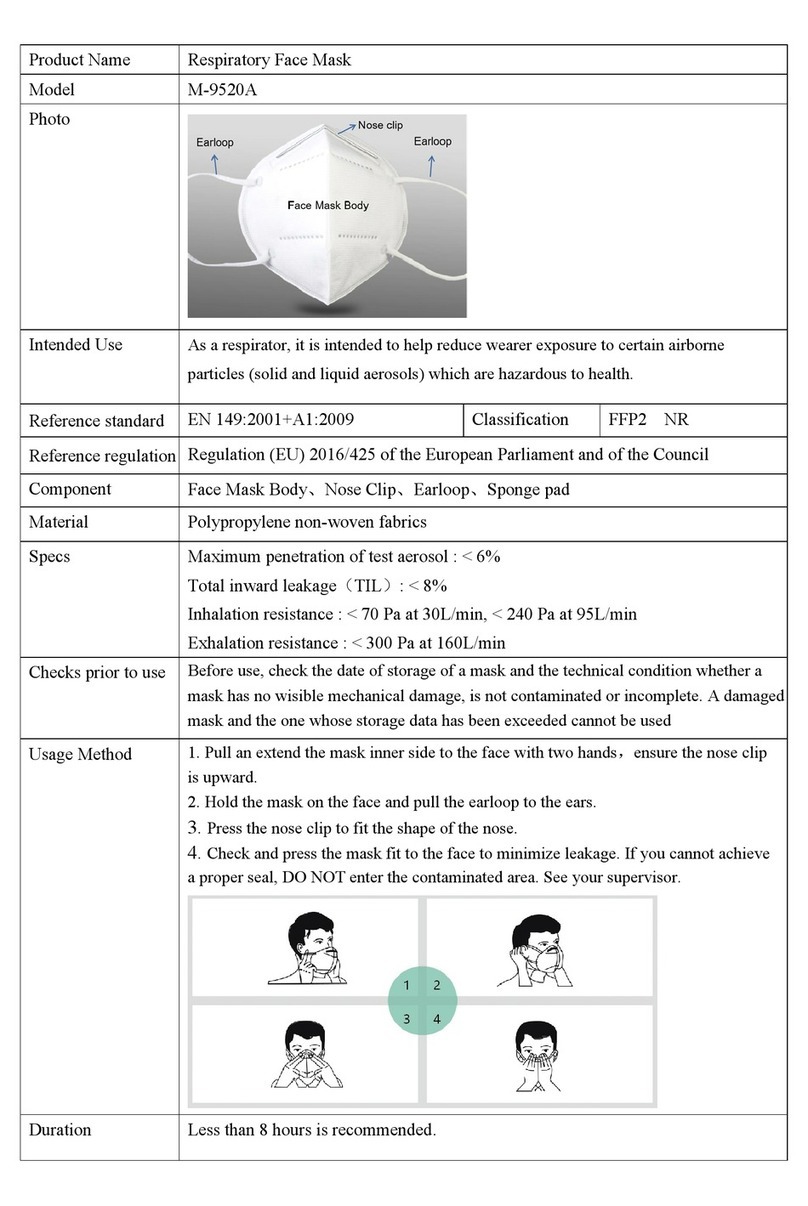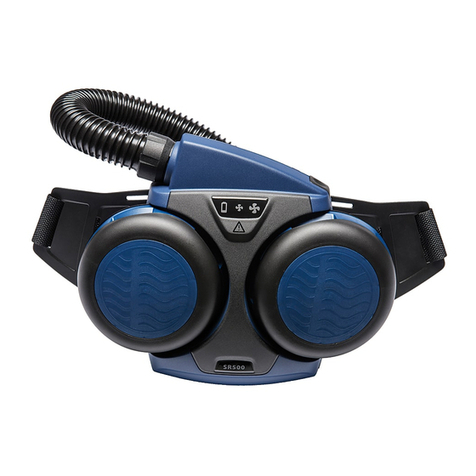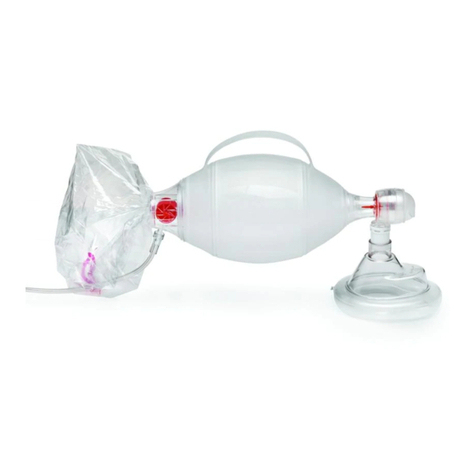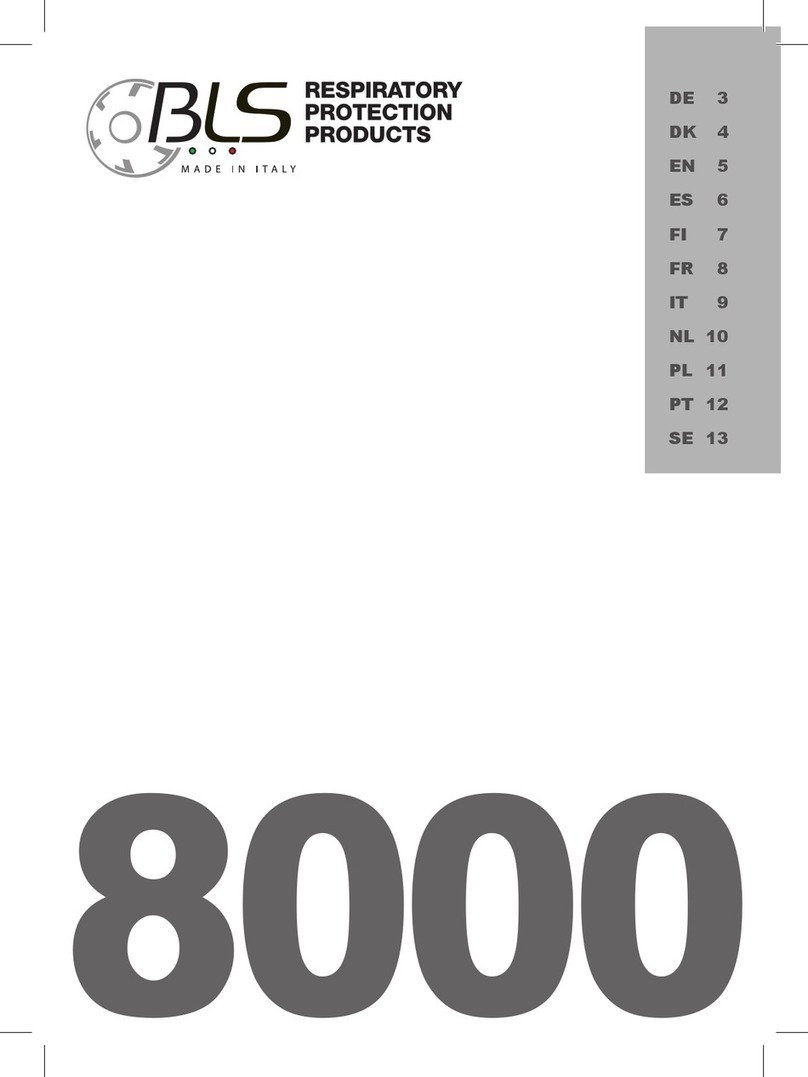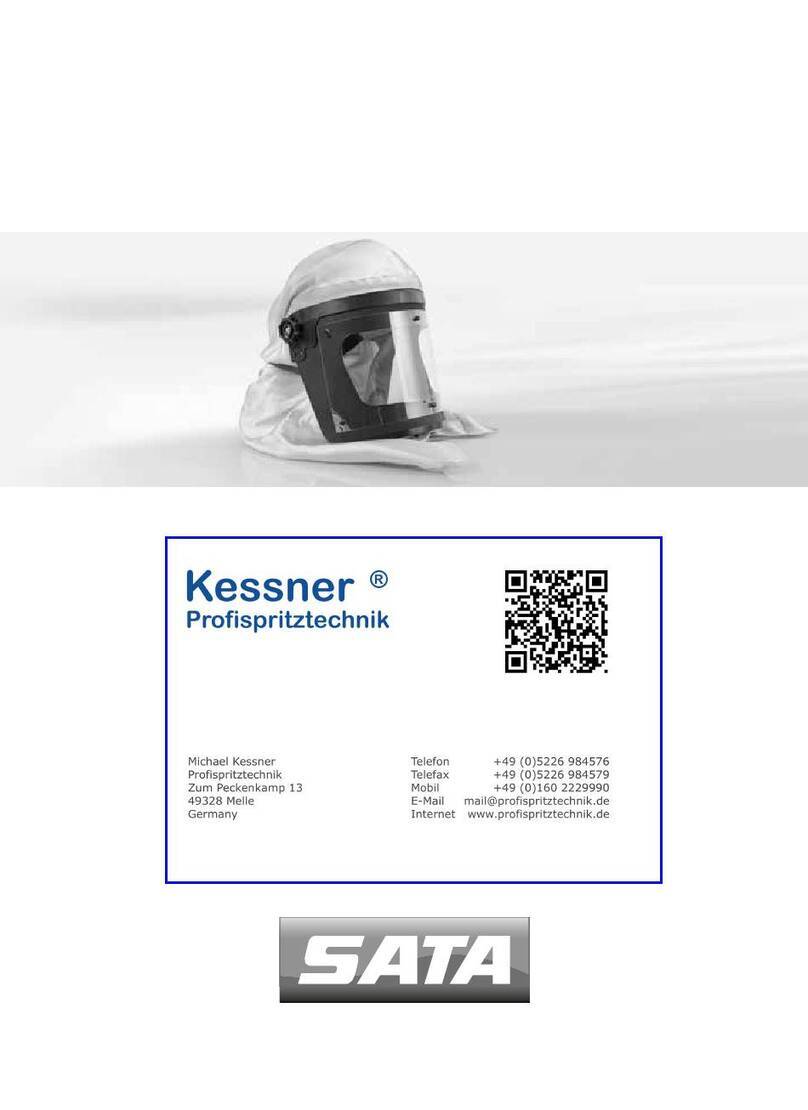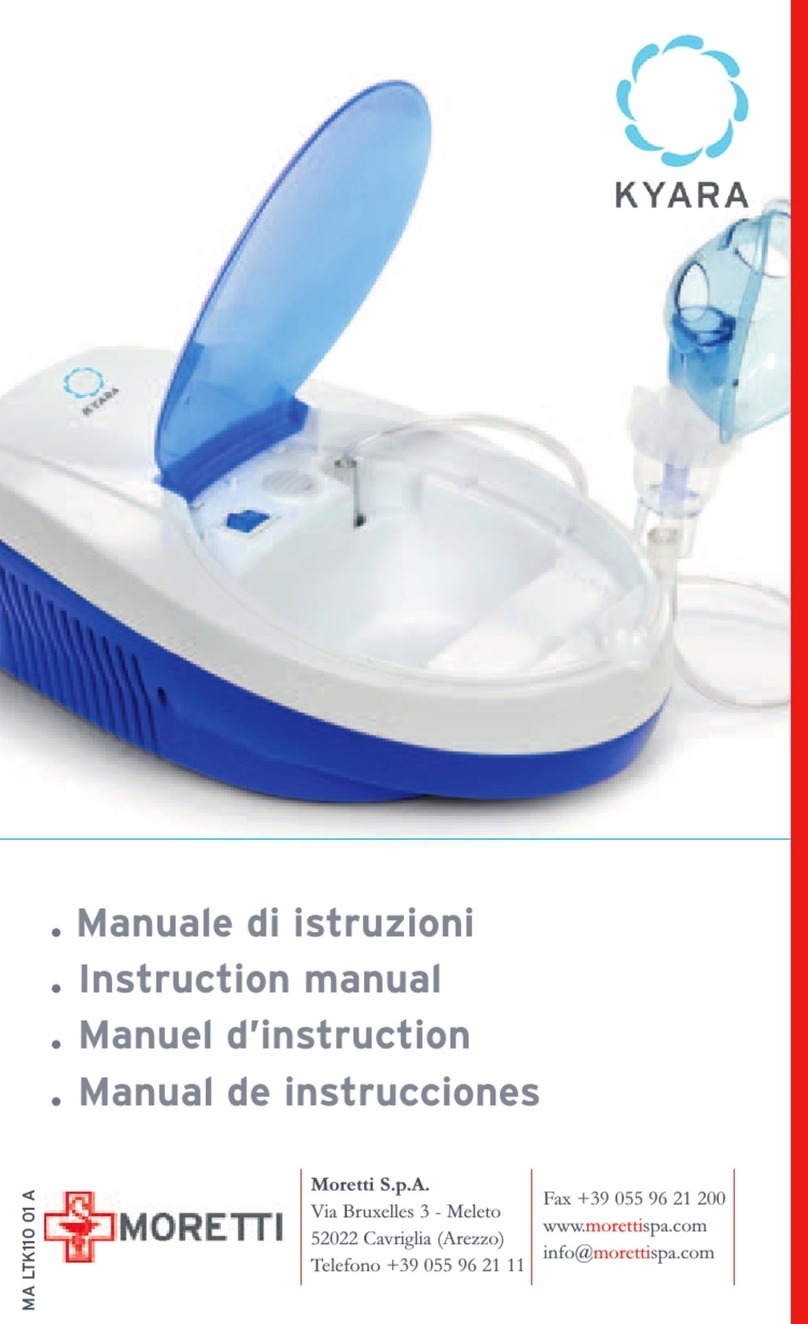
3711974 (A3-D-P) Page 2/3
PAS®Micro CFH
Self-contained breathing apparatus Instructions for use
1. Fully tear open the pouch (Fig. 6) and remove the hood.
Fig. 6 Removing the hood from the pouch
2. Fully open the cylinder valve.
3. Immediately put on the hood as follows:
– Place both hands inside the neck seal and carefully stretch the
hood over the head.
– Wearers with spectacles – take care when stretching the neck
seal over the spectacles.
– Wearers with long hair – tuck the hair inside the hood.
– Position the nose cup over the nose and mouth and breathe
normally.
4. Complete the required operation and then retreat to a safe area
without removing the hood.
With a fully charged cylinder, the warning whistle will sound to warn
of low cylinder pressure after approximately 11 minutes after opening
the cylinder valve. The wearer will have approximately 6 minutes to
evacuate to a safe area after the warning whistle sounds.
4.3 After use
WARNING
Removing the breathing apparatus in a hazardous breathing environment
is unsafe.
►Do not remove the breathing apparatus until in safe breathing
environment.
CAUTION
Careless handing could damage the breathing apparatus and cause the
release of high-pressure air.
►Do not drop or throw down the breathing apparatus.
1. Remove the hood as follows:
– Place both hands inside the neck seal and carefully stretch the
hood over the head.
– Breathe normally after removing the hood.
2. Fully close the cylinder valve.
– Pull the hand wheel against spring force, and simultaneously turn
it clockwise.
3. Loosen the harness by opening the waist belt buckle and lifting the
shoulder strap buckles.
4. Remove the breathing apparatus.
5. Discard the plastic storage pouch.
6. Carry out a visual inspection (see section 6.4.1).
7. Pass the breathing apparatus to trained service personnel or Dräger
to refill the cylinder and repair any faults or damage.
5 Troubleshooting
The troubleshooting guide shows fault diagnosis and repair information
applicable to breathing apparatus users. Further troubleshooting and
repair information is available in instructions for use supplied with the
associated equipment.
Contact service personnel or Dräger when the remedy information
indicates a service task, or if the symptom remains after all remedy
actions have been attempted.
6 Maintenance
6.1 Daily check
The breathing apparatus must be ready for use at all times. Dräger
recommend that the following check is carried out daily.
– Check that the pointer on the cylinder pressure gauge is inside the
green area. If the pointer is in the red area, inform trained service
personnel or Dräger immediately.
If the customer’s risk assessment concludes that less regular checks
are acceptable, the frequency of the check can be extended to a
maximum of monthly. It is the responsibility of the customer to ensure that
the breathing apparatus is ready for use at all times.
6.2 Maintenance table
Dräger recommend servicing and testing the breathing apparatus,
including out-of-use apparatus, in accordance with the maintenance
table.
– Record all service details and testing.
– Refer also to the instructions for use for associated equipment.
– Extra inspection and testing might be required in the country of use to
comply with national regulations.
6.3 Cleaning and disinfecting
CAUTION
Trapped water and ice inside the pneumatic system can impair the
operation of the product.
►Prevent any liquid from entering the pneumatic system, and
thoroughly dry the product after cleaning and disinfecting.
NOTICE
Using cleaning and disinfecting methods not described in this section can
damage the equipment.
►Do not exceed 60 °C for drying, and remove components from the
drying facility immediately when dry. Drying time in a heated dryer
must not exceed 30 minutes.
►Do not immerse pneumatic or electronic components in cleaning and
disinfecting solutions or water.
For information about suitable cleaning and disinfecting
agents and their specifications refer to document 9100081 at
www.draeger.com/IFU.
6.3.1 General cleaning and disinfecting
Clean the product if it is dirty. If the product has been exposed to
contaminants, disinfect any components that come into direct and
prolonged contact with the skin.
Refer also to the instructions for use for other associated equipment.
Work equipment
– Clean, lint free cloths.
1. Clean the product manually using a cloth moistened with cleaning
solution to remove excess dirt.
2. Apply disinfecting solution to components that come into direct and
prolonged contact with the skin.
3. Remove all cleaning and disinfecting agents by rinsing all
components thoroughly with clean water.
4. Dry all components using a dry cloth, in a heated dryer, or in air.
5. Contact service personnel or Dräger if disassembly of the pneumatic
system or electronic components is required.
6.4 Maintenance tasks
6.4.1 Visual inspection
A visual inspection must fully check the product including all component
parts and accessories.
1. Check that the product is clean and undamaged, paying particular
attention to pneumatic system components, connectors, and
elastomeric components such as hoses.
– Typical signs of damage that can affect the operation of the
product include impact, abrasion, cutting, corrosion, and
discoloration.
2. Report damage to service personnel or Dräger, and do not use the
product until faults are rectified.
6.4.2 Stowing the hood in the storage pouch
This is a place holder module for stowing the hood if it is needed.
1. Disconnect the hood hose from the breathing apparatus.
2. Carefully roll up the hood, ensuring that the visor is not creased or
folded.
3. Pass the connecting hose through the hole in the storage pouch as
shown (Fig. 7).
– The illustrations printed on the pouch should be facing upwards.
Fig. 7 Folding the hood and placing it into the pouch
4. Fit the hood into the storage pouch.
5. Remove the cover from the adhesive strip.
6. Seal the pouch by folding the adhesive strip over the opening of the
pouch (Fig. 8).
Fig. 8 Sealing the pouch
7. Connect the pouch to the breathing apparatus (see section 6.4.3).
6.4.3 Connecting the pouch to the breathing apparatus
1. Connect the pouch to the right-hand buckle of the breathing
apparatus (Fig. 9).
2. Connect the hood hose to the breathing apparatus.
Fig. 9 Connecting the pouch to the breathing apparatus
6.4.4 Fitting the air cylinder
CAUTION
Only air cylinders listed in the Dräger certification are approved for use.
►Only fit an air cylinder which is approved for use. Contact Dräger for
further information.
1. Ensure that the pointer of the pressure indicator is in the green sector.
2. Place the carrying harness on a clean flat surface.
3. Ensure that the following are clean and undamaged.
– The threads of the high-pressure connector (Fig. 10) and cylinder
valve.
– The O-ring (Item 1).
– The sintered filter (Item 2).
Fig. 10 High-pressure connector
4. Fully extend the cylinder strap.
52096
Symptom Fault Remedy
Air leak from the
medium-pressure hose
connection at the pres-
sure reducer (safety
relief valve)
Fault O-ring, retainer,
spring or pressure
reducer
Service task
Incorrect flow rate Pressure reducer fault Service task
Medium-pressure hose
fault
Service task
Poor sounding whistle Whistle dirty Clean whistle flute and
retest
Whistle not functioning
correctly
Activation mechanism
fault
Service task
Component
or System
Task Every
month
Every
year
Every 6
years
Complete
breathing
apparatus
Visual inspection (see
section 6.4.1)
X1)
1) Clean the breathing apparatus if it is dirty. If the breathing apparatus has been
exposed to contaminants, disinfect any components that come into direct and
prolonged contact with the skin.
Breathing cycle and static
tests
X2)
2) These maintenance tasks can only be carried out by Dräger or trained service
personnel. Details of the tasks are contained in the technical manual which is
issued to service personnel that have attended a relevant Dräger maintenance
course.
Pressure
reducer
Inspect the sintered filter X2),3)
3) Replace the sintered filter if a drop in pressure reducer performance is observed
during a flow check or if it is visibly damaged.
Inspect the high-pressure
connector O-ring
X2),4)
4) Replace the high-pressure connector O-ring if it leaks or is visibly damaged.
Overhaul. Contact Dräger
for the Repair Exchange
(REX) service
X5)
5) Where the breathing apparatus is subjected to a high level of use (in training
establishments etc.), reduce the overhaul period for the pressure reducer. In
these circumstances, Dräger recommend that the overhaul frequency should be
less than 5000 applications of use. An application of use is defined as a single
use of the fully assembled breathing apparatus, where the user breathes from
the air cylinder.
Cylinder Check the test date of the
cylinder
X
Recertification According to national regu-
lations in the country of use
Valve overhaul During cylinder recertifica-
tion
52098520995210047464


